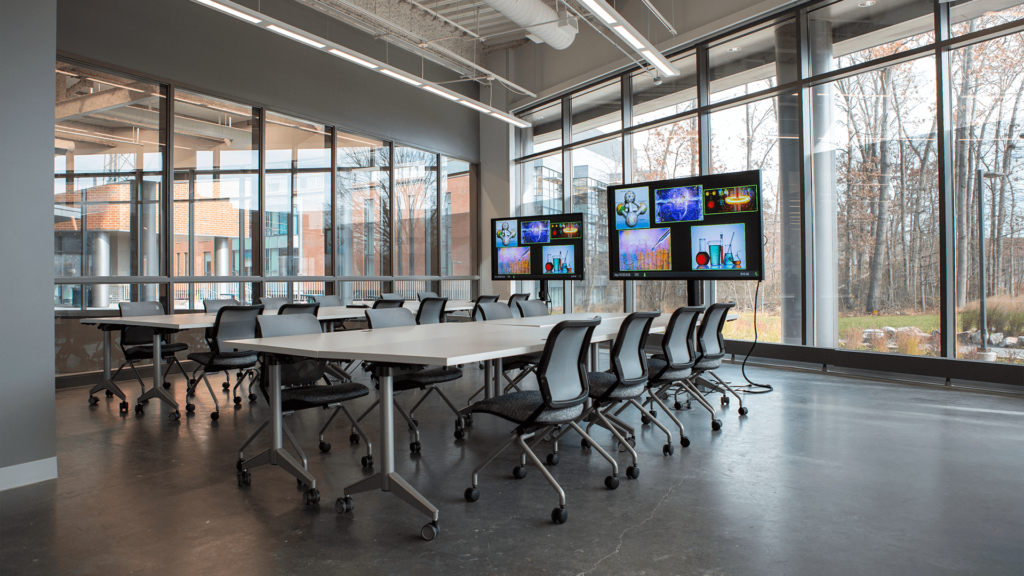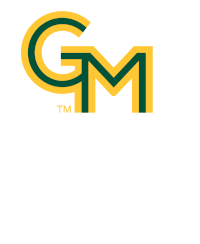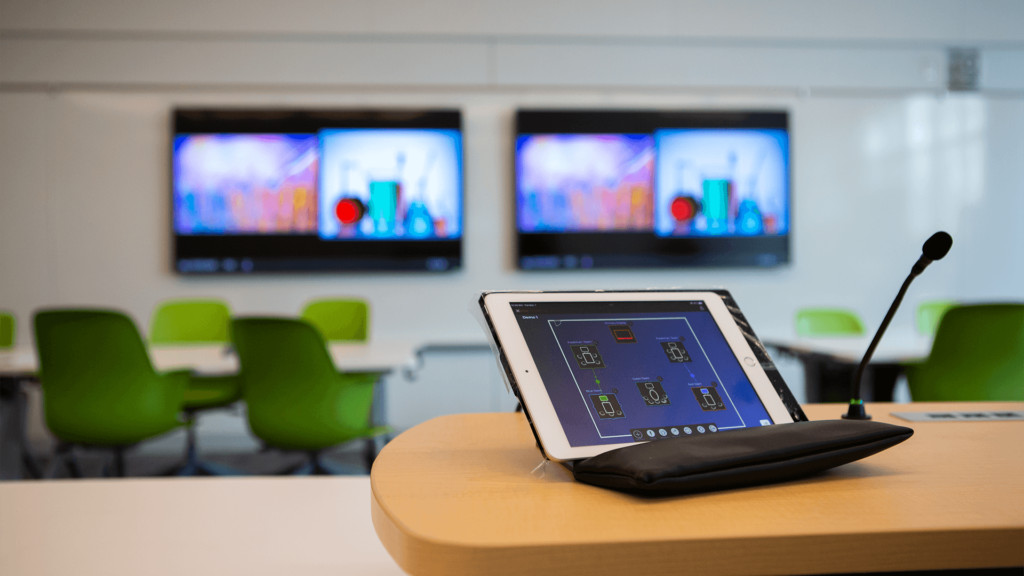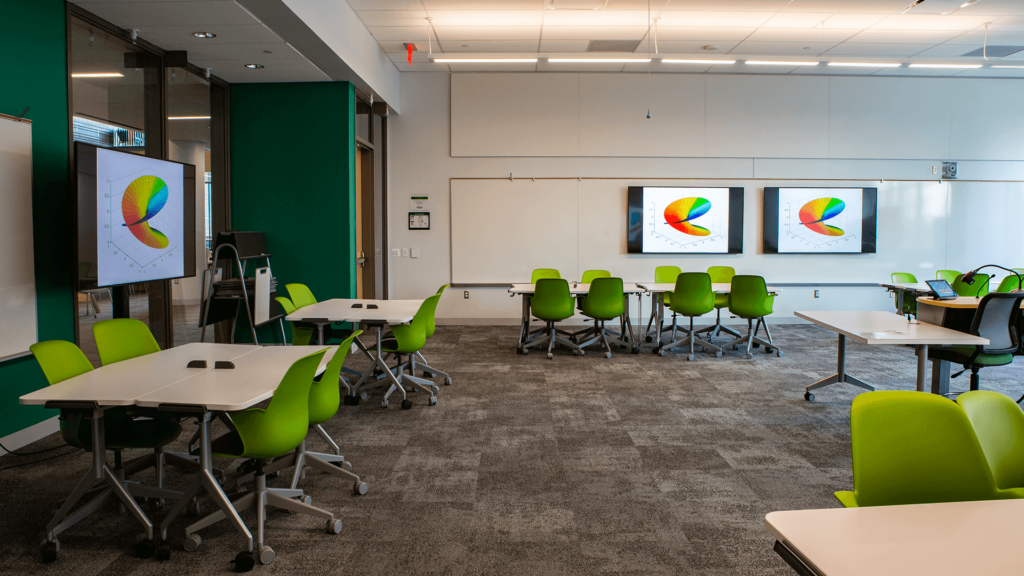

George Mason University Creates Transformational Active Learning Environments With Mersive Solstice
George Mason University, GMU, is Virginia’s largest public research university. The primary campus in Fairfax, Virginia, focuses on bold, progressive education that serves its students and faculty. Adhering to their core value, “Innovation is Our Tradition,” GMU strives to give their academic community the tools needed for a transformational learning experience that helps them grow as individuals, scholars, and professionals.
The newest building on GMU’s Fairfax campus is Horizon Hall. Opened in January 2021, the six-floor, 218,000-square-foot academic building includes state-of-the-art active learning classrooms and collaborative learning spaces, a significant asset to the GMU community. Active learning classrooms are defined as flexible, student-centered, technology-rich classrooms. During the 4-5 year project, GMU’s goal was to be innovative in all aspects of Horizon Hall, from the building and room design to the technology, all elements that enhance the academic experience and lead to better learning outcomes.
“Our goal for Horizon Hall was to be innovative overall in our thought process and in achieving the goals of the University,” noted Crystal Clemons, M.Ed, Director, Classroom and Lab Technologies at GMU. “When you walk in, it’s really an experience more than anything else. As students enter the building, there are thought-provoking displays that are designed to provide inspiration. This was a goal for the building and the aura.” This atmosphere sets the tone for the progressive pedagogy and innovative learning spaces throughout Horizon Hall.

INDUSTRY
- Higher Education
SERVICES
- Active Learning
- Collaborative Learning
LOCATION
- Fairfax, VA USA
George Mason University's Challenge
During the Horizon Hall project, GMU had the initiative that at least 30% of all classrooms support active learning pedagogy. To meet this challenge, Clemons explained, “We wanted to provide and leverage flexibility in these spaces.” The learning spaces in Horizon Hall were designed to accommodate 30-square-feet per student, include lots of white board space, and utilize movable furniture. “Everything is movable. We’ve even designed the lectern to be movable,” she noted. “We really designed to take full advantage of flexibility. Given this,” she noted, “we wanted to include technologies that would also enhance and leverage that flexibility.”
“You don’t find a lot of schools or colleges going the route where all of their classrooms are active learning in nature,” said Ajinkya Patil, lead project designer from Convergent Technologies Design Group. “There is no fixed seating at all. That was part of the uniqueness of this project.”
Without any fixed seating, facilitating an active learning classroom would require a way for both faculty and students to collaborate and share content from anywhere in the classrooms. Wireless content sharing was a critical point that GMU needed to achieve in Horizon Hall. In addition to enabling faculty to walk around the collaborative space and share from their laptop or tablet, it was also important that the students could do the same. “Having the students be able to wirelessly connect, work with their groups, and share throughout the room was key, as well,” explained LeAnn Pittman, Learning Space Design Manager at GMU.
Another significant requirement to fully utilize a wireless content sharing platform was BYOD (bring your own device). Faculty and students needed the ability to bring any wireless device to the space, and no matter the type of device – laptop, tablet, or smartphone; Android or iOS; PC or Mac, etc. – it would need to work well and integrate with the wireless collaboration platform in the room. It was vital to have technology solutions for Horizon Hall that supported both faculty and student groups.
Finally, GMU needed to have a reliable wireless solution that would work seamlessly on the GMU network, accommodating the flexibility of the spaces without compromising security. The flexibility and wireless nature of the project meant there were technical design challenges to consider. “This was, on such a large scale, probably our first project where there were no dedicated AV rooms,” explained Patil. “All of the AV throughout such a large building is riding completely on the network, which becomes a challenge in itself. That is what makes this project pretty unique. With all the AV and IT collocated, we had to work in very close coordination with the IT team.” Security was a critical requirement and design consideration for this project.
Key requirements for Horizon Hall’s collaboration technology included:
Wireless Content Sharing
Wireless Content Sharing to support flexible, active learning spaces and enable faculty and students to wirelessly share content from anywhere in the room.
BYOD Compatibility
BYOD Compatibility, allowing faculty and students to easily collaborate and share content from any type of device – laptop, tablet, or smartphone – or operating system.
Intuitive technology
Intuitive technology that was easy to use and understand, requiring little to no training for faculty and students.
Security and scalability
Security and scalability to accommodate integration with GMU’s network and the ability to easily scale and add devices as their educational technology needs evolve or expand.
Solution
The design and technology considerations and implementation for Horizon Hall fell to the expertise of Convergent Technology Design Group, Inc. (CTDG), with Corbett Technology Solutions (CTSI) as the systems integrator for the project. Working together with the project architect, Perkins & Will, and GMU’s AV and IT leads, including Clemons and Pittman, CTDG designed the flexible learning spaces and deployed Mersive Solstice as a complementary technology solution that would fit the goals and requirements of GMU and the Horizon Hall building, specifically. Having deployed Solstice across the GMU campus before, CTDG recommended that Solstice would be a strong fit for the project and Horizon Hall’s active learning classrooms and educational goals.

The entire project included 165 Solstice Pods deployed across 28 classrooms, 15 collaboration spaces, 9 conference rooms, 8 huddle spaces, and within additional transitional spaces throughout Horizon Hall. Solstice’s content-sharing capabilities met the challenge of creating seamless collaboration within the building’s collaboration spaces and providing the perfect solution for team-oriented active learning classrooms.
“Behind every display in this building, there is a Solstice Pod” Clemons highlighted, “It’s supporting the teaching and learning here, the meeting rooms and conference rooms, and the informal spaces outside of the classrooms where students and faculty continue their discussions from the classroom.”
Several capabilities set Mersive Solstice apart from other technology solutions that the GMU team had researched.
Wireless sharing.
The fully wireless content sharing solution was essential for Horizon Hall. Long wires spread across the room in a flexible, active space can distract from the learning experience. The absence of dedicated AV rooms also made a wired solution impractical. Solstice’s wireless content sharing capability also eliminated maintenance issues with cables and other room hardware, creating a seamless learning environment for the entire GMU academic community. “We have Solstice in small group study rooms so students can come in and work together on group projects and use Solstice to share. We don’t have to worry about any cables getting lost or stolen – so it’s really great for that as well.”
Ability to BYOD.
It was essential that GMU faculty and students be able to BYOD at Horizon Hall. “BYOD was a key factor for GMU and for any design consultations in this project,” CTDG’s Patil noted. “Where the faculty, the students, could bring any wireless device – an iPhone, a laptop – anything you can imagine – they wanted the ability for that device to work well and integrate well with the existing AV systems within the room, and Mersive does that.”
Easy to use.
Solstice’s ease of use was a significant factor for GMU. The solution is very intuitive for both students and faculty when used in the classroom. The intuitive technology allows for seamless sharing options and flexibility in the classroom. Solstice is also very versatile in the classrooms, enabling presentation, wireless collaboration, and team-based active and collaborative learning environments.
Secure and Scalable.
Solstice provides seamless integration to GMU’s network to support the collaborative learning spaces. Solstice is also designed with security and scalability in mind, two critical factors for GMU’s Horizon Hall. “The secure nature of Mersive – because it was going to be integrated with the network,” Patil explained, “we wanted something that was going to be reliable, secure – also scalable – that you can add as many as you need for such a large project. We kept these characteristics in mind when we included Mersive.”
“Behind every display in this building, there is a Solstice Pod. It’s supporting the teaching and learning here, the meeting rooms and conference rooms, and the informal spaces outside of the classrooms where students and faculty continue their discussions from the classroom.”
– Crystal Clemons, M.Ed, Director, Classroom and Lab Technologies, GMU
Results
George Mason University has been exceedingly pleased with Mersive Solstice. The wireless content sharing solution supports the teaching and active learning pedagogy employed throughout Horizon Hall. The meeting rooms, conference rooms, and informal meeting spaces throughout the building outfitted with Solstice have aided the goal of creating an active learning space for the GMU community.
“Pittman explained how beneficial Solstice has been in enabling collaborative and engaging active learning environments. “Utilizing multiple screens in a room where each one is tied to a Solstice Pod, the professor can say – ’Hey, I like what group two is doing’ and they can share group two’s display to all of the displays in the room. Having the students be able to wirelessly connect to Solstice as a group, and then share throughout the room – that was key,” she noted, helping to achieve a key goal for GMU’s wireless content sharing solution.
Number of learning spaces in Horizon Hall that accommodate wireless collaboration content-sharing with Solstice
Number of cable/hardware replacements since installing Solstice
Increased use from council staff and community members
Implementing Solstice across these spaces accommodated the technology capabilities and requirements necessary for presentation, collaboration, and active learning for both faculty and students.
And, while not an original requirement for the technology – the ability to provide a touchless solution for faculty and students, enabling them to connect to the technology and collaborate using only their own device, has become extremely important since the onset of the pandemic and a focus on touch-free infrastructure.
“One thing we noticed,” Clemons explained, “is that a lot of the faculty wanted to use their own laptop versus touch the computer that we had provided in the room.” Pittman added, “Nobody wants to touch the keyboard and mouse in the room. Nobody wants to touch a cable. They want to wirelessly connect to Solstice.” Solstice enables this touch-free infrastructure with a software interface that allows users to connect, share, and collaborate using only their own devices.
Conclusion
Overall, GMU has had enormous success with Mersive technology. Solstice provides a wireless solution that anyone can utilize across multiple collaboration and active learning spaces throughout Horizon Hall. Solstice also addresses GMU’s primary pain points and technology requirements, providing a wireless solution that is not only secure and scalable, but easy to use for both faculty and students at the University.
Bill Holaday, Principal at CTDG, emphasized how well Mersive fit the design goals and requirements for the project. “The Mersive solution worked out VERY WELL because it’s easy to connect to, it’s a known quantity on the campus, and the user interface is simple and streamlined. And, given the hundreds of points of access to present with displays – some of the rooms have 8-10 displays that everyone can present to locally in collaboration mode – a solution that wouldn’t bog down the network and cause connectivity issues and that was quick and easy to connect to – those were key points from a design standpoint that really made Mersive Solstice make sense for this project.”
In addition to use throughout Horizon Hall, GMU has standardized on Mersive Solstice across their campus to achieve their goals of innovation for their academic community. “Everything we do now includes a Solstice Pod,” Pittman noted. “It’s not just the classrooms, we’ve moved to including them in the design of conference rooms, meeting spaces, and informal gathering spaces. If there is a display, there is a Solstice Pod.”
Want to read more? See what AV Technology wrote about this project.
